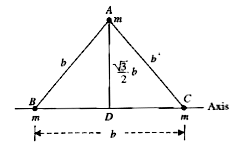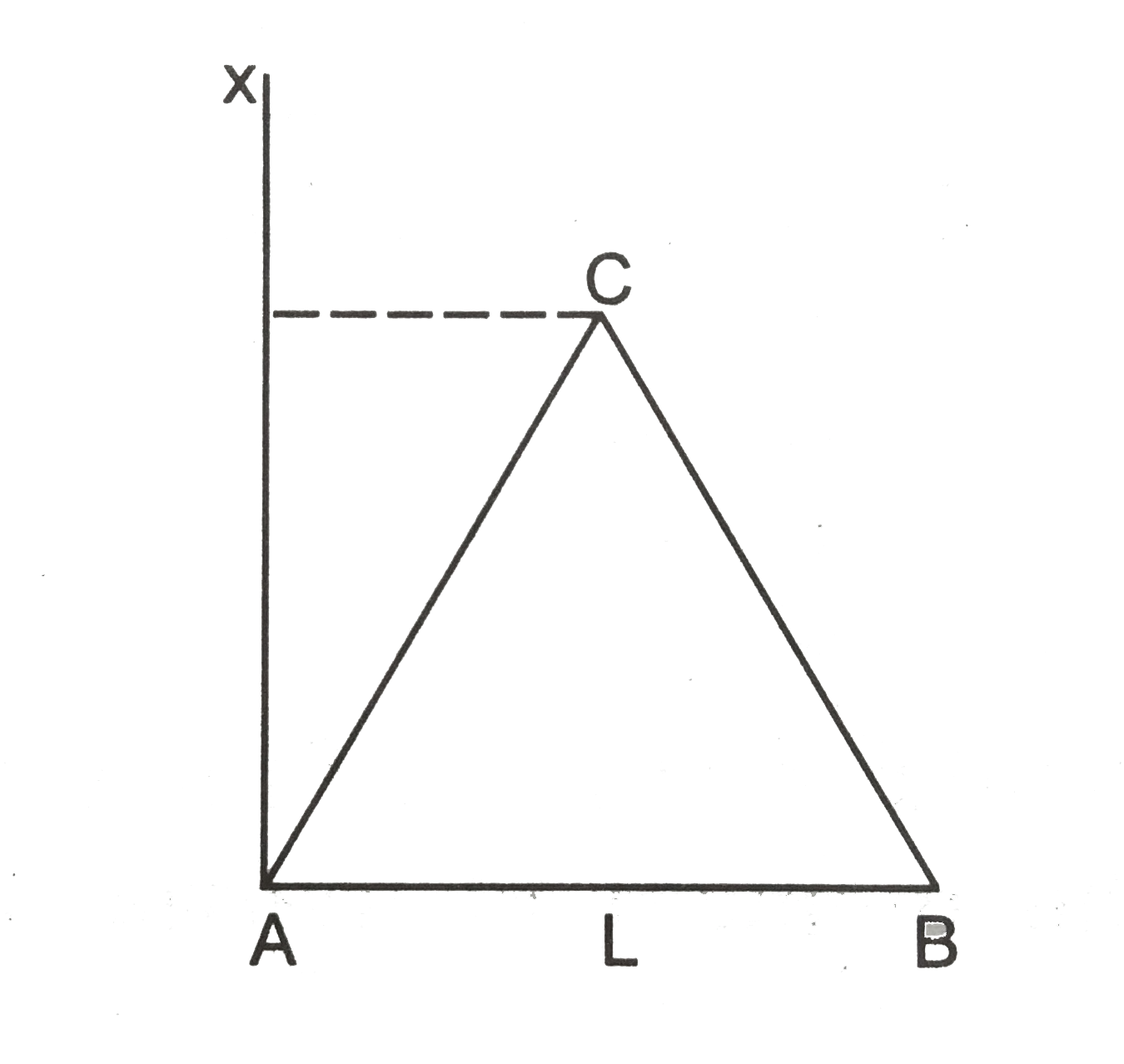Three point masses m1,m2 and m3 are located at the vertices of an equilateral triangle of side α. What is the moment of inertia of the system about an axis along the altitude of the triangle passing through m1?
To find the moment of inertia of the system of three point masses located at the vertices of an equilateral triangle about an axis along the altitude of the triangle passing through one of the masses, we can follow these steps:
1. Identify the Configuration:
We have three point masses m1,m2, and m3 located at the vertices of an equilateral triangle with side length α. The axis of rotation is along the altitude of the triangle passing through mass m1.
2. Determine the Position of the Masses:
In an equilateral triangle, the altitude divides the triangle into two right triangles. The length of the altitude h can be calculated using the formula:
h=√32α
The distance from the vertex m1 to the midpoint of the opposite side (where m2 and m3 are located) is α2.
3. Calculate the Perpendicular Distances:
- The distance r1 of mass m1 from the axis is 0 (since it lies on the axis).
- The distances r2 and r3 of masses m2 and m3 from the axis are both α2.
4. Apply the Moment of Inertia Formula:
The moment of inertia I about the axis is given by the sum of the products of each mass and the square of its distance from the axis:
I=m1r21+m2r22+m3r23
Substituting the values:
I=m1(0)2+m2(α2)2+m3(α2)2
Simplifying this gives:
I=0+m2(α24)+m3(α24)
I=α24(m2+m3)
5. Final Result:
Therefore, the moment of inertia of the system about the specified axis is:
I=α24(m2+m3)
We have three point masses m1,m2, and m3 located at the vertices of an equilateral triangle with side length α. The axis of rotation is along the altitude of the triangle passing through mass m1.
In an equilateral triangle, the altitude divides the triangle into two right triangles. The length of the altitude h can be calculated using the formula:
h=√32α
The distance from the vertex m1 to the midpoint of the opposite side (where m2 and m3 are located) is α2.
- The distance r1 of mass m1 from the axis is 0 (since it lies on the axis).
- The distances r2 and r3 of masses m2 and m3 from the axis are both α2.
The moment of inertia I about the axis is given by the sum of the products of each mass and the square of its distance from the axis:
I=m1r21+m2r22+m3r23
Substituting the values:
I=m1(0)2+m2(α2)2+m3(α2)2
Simplifying this gives:
I=0+m2(α24)+m3(α24)
I=α24(m2+m3)
Therefore, the moment of inertia of the system about the specified axis is:
I=α24(m2+m3)
Topper's Solved these Questions
- ROTATIONBOOK - DC PANDEY ENGLISHCHAPTER - ROTATIONEXERCISE - Check point 9.1
20 Videos
- ROTATIONBOOK - DC PANDEY ENGLISHCHAPTER - ROTATIONEXERCISE - Check point 9.2
20 Videos
- RAY OPTICSBOOK - DC PANDEY ENGLISHCHAPTER - RAY OPTICSEXERCISE - Integer type q.
14 Videos
- ROTATIONAL MECHANICSBOOK - DC PANDEY ENGLISHCHAPTER - ROTATIONAL MECHANICSEXERCISE - Subjective Questions
2 Videos
Similar Questions
Three masses of 2 kg, 3 kg and 4 kg are located at the three vertices of an equilateral triangle of side 1 m. What is the M.I. of the system about an axis along the altitude of the triangle and passing through the 3 kg mass?
View SolutionThree balls of masses 1kg,2kgand3kg are arranged at the corners of an equilateral triangle of side 1m. What will be the moment of inertia of the system and perpendicular to the plane of the triangle.
View Solution
Knowledge Check
Three point masses each of mass m are placed at the corners of an equilateral triangle of side b. The moment of inertia of the system about an axis coinciding with one side of the triangle is
 A3mb2Bmb2C(3/4)mb2D(2/3)mb2
A3mb2Bmb2C(3/4)mb2D(2/3)mb2Three particles of masses 1kg,32kg,and2kg are located the vertices of an equilateral triangle of side a. The x,y coordinates of the centre of mass are.
Aa. 5a9,2a3√3Bb. 2a3√3,5a9Cc. 5a9,2a√3Dd. 2a√3,5a9
Three point masses m1=2Kg,m2=4kgandm3=6kg are kept at the three corners of an equilateral triangle of side 1 m. Find the locationo of their center of mass.
View SolutionThree mass points each of mass m are placed at the vertices of an equilateral triangle of side 1. What is the gravitational field and potential due to the three masses at the centroid of the triangle ?
View SolutionThree mass points each of mass m are placed at the vertices of an equilateral tringale of side l. What is the gravitational field and potential due to three masses at the centroid of the triangle ?
View SolutionThree masses 3, 4 and 5 kg are placed at the centre of an equiliteral triangle of 1 m sides. Locate its centre of mass.
View SolutionThree particles, each of mass 200 g are kept at the corners of an equilateral triangle of side 10 cm. Find the moment of inertia of the system about an axis
a. joining two of the particles
b. passing through one of the particle perpendicular to the plane of the particles.
View SolutionThree particles, each of mass m are situated at the vertices of an equilateral triangle ABC of side L as shown in the figure. Find the moment of inertia of the system about the line AX perpendicular to AB in the plane of ABC

View Solution
